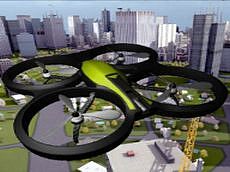Drone Flight Simulator
Description:
Drone Flight Simulator
Are you an aspiring drone pilot looking to enhance your flying skills? Or are you simply interested in experiencing the thrill of piloting a drone without the risk of crashing? Look no further! In this comprehensive guide, we will explore the exciting world of drone flight simulators. From the basics of drone simulation to advanced features and tips, this article has everything you need to know to become a proficient drone pilot in a virtual environment.
What is a Drone Flight Simulator?
Introduction to Drone Simulators
A drone flight simulator is a computer program or application that replicates the flight of a real drone in a virtual environment. These simulators are designed to provide an accurate and realistic flying experience, allowing users to practice and improve their piloting skills without the risk of damaging expensive equipment.
Benefits of Using a Drone Simulator
Safe Learning Environment: One of the primary benefits of using a drone simulator is the ability to practice flying in a safe and controlled environment. Users can experiment with different flying techniques and maneuvers without the fear of crashing or damaging their drones.
Cost-Effective Training: Drone simulators are a cost-effective alternative to traditional flight training. Users can gain valuable experience and improve their skills without the need for expensive equipment or training sessions.
Realistic Flight Experience: Advanced simulators offer realistic physics and flight dynamics, providing users with an authentic flying experience. This can be particularly useful for pilots looking to improve their skills in challenging weather conditions or complex flight scenarios.
Key Features of Drone Simulators
Flight Modes: Simulators offer various flight modes, including manual, GPS-assisted, and stabilized modes. This allows users to practice different flying techniques and adjust the level of difficulty based on their skill level.
Scenarios and Challenges: Many simulators offer pre-configured scenarios and challenges, such as obstacle courses, aerial photography missions, and emergency landing scenarios. These challenges help users improve their piloting skills and test their abilities in different scenarios.
Customization Options: Users can customize various aspects of the simulation, such as weather conditions, time of day, and drone settings. This allows for a highly personalized and tailored training experience.
Multiplayer Support: Some simulators offer multiplayer support, allowing users to fly with friends or compete in virtual races and challenges. This adds a social and competitive element to the simulation experience.
Choosing the Right Drone Simulator
Factors to Consider
Compatibility: Ensure that the simulator is compatible with your operating system and hardware. Some simulators are designed specifically for Windows, macOS, or Linux, while others are compatible with multiple platforms.
Realism: Look for simulators that offer realistic physics and flight dynamics. A realistic simulation will provide a more authentic flying experience and allow you to practice real-world flying techniques.
Features: Consider the features and capabilities of the simulator, such as flight modes, scenarios, and customization options. Choose a simulator that offers the features you need to achieve your training goals.
User Interface: A user-friendly interface is essential for a positive simulation experience. Look for simulators with intuitive controls and menus that are easy to navigate.
Community Support: Consider simulators that have an active user community and support forums. This can be valuable for troubleshooting issues, sharing tips and tricks, and finding additional content and resources.
Are you an aspiring drone pilot looking to enhance your flying skills? Or are you simply interested in experiencing the thrill of piloting a drone without the risk of crashing? Look no further! In this comprehensive guide, we will explore the exciting world of drone flight simulators. From the basics of drone simulation to advanced features and tips, this article has everything you need to know to become a proficient drone pilot in a virtual environment.
What is a Drone Flight Simulator?
Introduction to Drone Simulators
A drone flight simulator is a computer program or application that replicates the flight of a real drone in a virtual environment. These simulators are designed to provide an accurate and realistic flying experience, allowing users to practice and improve their piloting skills without the risk of damaging expensive equipment.
Benefits of Using a Drone Simulator
Safe Learning Environment: One of the primary benefits of using a drone simulator is the ability to practice flying in a safe and controlled environment. Users can experiment with different flying techniques and maneuvers without the fear of crashing or damaging their drones.
Cost-Effective Training: Drone simulators are a cost-effective alternative to traditional flight training. Users can gain valuable experience and improve their skills without the need for expensive equipment or training sessions.
Realistic Flight Experience: Advanced simulators offer realistic physics and flight dynamics, providing users with an authentic flying experience. This can be particularly useful for pilots looking to improve their skills in challenging weather conditions or complex flight scenarios.
Key Features of Drone Simulators
Flight Modes: Simulators offer various flight modes, including manual, GPS-assisted, and stabilized modes. This allows users to practice different flying techniques and adjust the level of difficulty based on their skill level.
Scenarios and Challenges: Many simulators offer pre-configured scenarios and challenges, such as obstacle courses, aerial photography missions, and emergency landing scenarios. These challenges help users improve their piloting skills and test their abilities in different scenarios.
Customization Options: Users can customize various aspects of the simulation, such as weather conditions, time of day, and drone settings. This allows for a highly personalized and tailored training experience.
Multiplayer Support: Some simulators offer multiplayer support, allowing users to fly with friends or compete in virtual races and challenges. This adds a social and competitive element to the simulation experience.
Choosing the Right Drone Simulator
Factors to Consider
Compatibility: Ensure that the simulator is compatible with your operating system and hardware. Some simulators are designed specifically for Windows, macOS, or Linux, while others are compatible with multiple platforms.
Realism: Look for simulators that offer realistic physics and flight dynamics. A realistic simulation will provide a more authentic flying experience and allow you to practice real-world flying techniques.
Features: Consider the features and capabilities of the simulator, such as flight modes, scenarios, and customization options. Choose a simulator that offers the features you need to achieve your training goals.
User Interface: A user-friendly interface is essential for a positive simulation experience. Look for simulators with intuitive controls and menus that are easy to navigate.
Community Support: Consider simulators that have an active user community and support forums. This can be valuable for troubleshooting issues, sharing tips and tricks, and finding additional content and resources.
Instructions:
WASD = MOVE
I K = UP, DOWN
J L = ROTATE
P - PAUSE
I K = UP, DOWN
J L = ROTATE
P - PAUSE
Categories:
Comments

You must log in to write a comment.
© Carnival Gamer 2024. All rights reserved. V-1.8.7









